| dc.contributor.advisor | Arindam Dutta. | en_US |
| dc.contributor.author | Ghatak, Sridipta. | en_US |
| dc.contributor.other | Massachusetts Institute of Technology. Department of Architecture. | en_US |
| dc.coverage.spatial | a-ii--- | en_US |
| dc.date.accessioned | 2020-01-23T16:58:23Z | |
| dc.date.available | 2020-01-23T16:58:23Z | |
| dc.date.copyright | 2019 | en_US |
| dc.date.issued | 2019 | en_US |
| dc.identifier.uri | https://hdl.handle.net/1721.1/123588 | en_US |
| dc.description | This electronic version was submitted by the student author. The certified thesis is available in the Institute Archives and Special Collections. | en_US |
| dc.description | Thesis: S.M., Massachusetts Institute of Technology, Department of Architecture, 2019 | en_US |
| dc.description | Cataloged from PDF version of thesis. | en_US |
| dc.description | Includes bibliographical references (pages 111-116). | en_US |
| dc.description.abstract | In theories of development, public infrastructure serves as one of the myriad mediums through which the state seeks validation. In the modern period, infrastructure has often served as the symbol of state led progress. Infrastructure is thus a project of endorsement and justification of state's intervention. It is superfluous to say that infrastructure is a contested terrain within which the political economy of development unfolds. However, this thesis argues that it is through this iteration of infrastructure's intricate ways of creation and functioning that private capital begins to accumulate in post-colonial India. The project looks at the discourse of industrial development and planning in late and post-colonial India, investigating the manner in which infrastructure appears as a trope not only for state's validation but also for aggregation of the Indian industrialist class. | en_US |
| dc.description.abstract | How are the modernizing technopolitical state and infrastructure entangled? The thesis attempts to answer this question by studying closely the iconic Howrah Bridge, a cast iron structure which opened to the public in 1943 forever transforming the urbanscape of the erstwhile British capital in the east, the city of Calcutta. The Howrah Bridge project allows entrance to the broader realm of public infrastructure and tests the boundary between 'public' and 'private' in development projects. Along with other engineering consultants the Tata group, a burgeoning industrial giant in the early 1900s took a pioneering role in this project by supplying almost singlehandedly the steel required to construct the bridge. | en_US |
| dc.description.abstract | On the one hand, Tata Company's involvement underscores how the corporate house was mediating questions of economic sovereignty parallel to their negotiation with the British colonial market; on the other hand, like other native capitalists of the time, the Tata group was simultaneously deeply implicated in nationalist arguments for sovereignty of the nation-state, involving debates around tariffs, rights recovery and the like. This thesis untangles the relationship between private capital and its implications in the institutional development of national planning in post-colonial India. The thesis highlights the ways in which late colonial strategies negotiated questions of foreign and native enterprise by constructing what would become the largest bridge in India in 1943. | en_US |
| dc.description.abstract | I argue that the construction history of Howrah Bridge offers an alternate, albeit subverted history of infrastructure in which the infrastructural object backgrounds the functioning of capital, thus establishing infrastructure as the fulcrum around which to pivot reading the history of state and capital. | en_US |
| dc.description.sponsorship | "The Schlossman Research Fellowship and MISTI summer grants have financially supported this work"--Page 8 | en_US |
| dc.description.statementofresponsibility | by Sridipta Ghatak. | en_US |
| dc.format.extent | 118 pages | en_US |
| dc.language.iso | eng | en_US |
| dc.publisher | Massachusetts Institute of Technology | en_US |
| dc.rights | MIT theses are protected by copyright. They may be viewed, downloaded, or printed from this source but further reproduction or distribution in any format is prohibited without written permission. | en_US |
| dc.rights.uri | http://dspace.mit.edu/handle/1721.1/7582 | en_US |
| dc.subject | Architecture. | en_US |
| dc.title | Industrial/statecraft : infrastructure and the making of industrial capitalism in India, ca. 1940 | en_US |
| dc.type | Thesis | en_US |
| dc.description.degree | S.M. | en_US |
| dc.contributor.department | Massachusetts Institute of Technology. Department of Architecture | en_US |
| dc.identifier.oclc | 1135857570 | en_US |
| dc.description.collection | S.M. Massachusetts Institute of Technology, Department of Architecture | en_US |
| dspace.imported | 2020-03-09T19:58:35Z | en_US |
